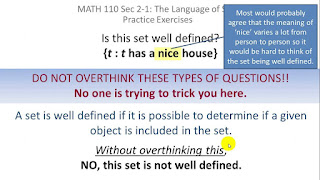
In mathematics, an expression is well defined or unambiguous if the definition provides an interpretation or a unique value. Otherwise, the expression is said to be undefined or ambiguous . A function is well defined if it gives the same result when the input representation is changed without changing the input value. For example if f takes the real number as input, and if f (0,5) is not equal f (1/2) then f is not well-defined (and therefore: not a function). The term well defined is also used to indicate whether the logical statement is not ambiguous.
Undefined functions are not the same as undefined functions. For example, if f ( x ) = 1/ x , then f (0) is undefined, but this has nothing to do with the question of whether f ( x ) = 1/ x is well defined. This; 0 is not in the function domain.
Video Well-defined
Contoh
Biarkan menjadi set, biarkan dan "define" sebagai jika dan jika .
Kemudian didefinisikan dengan baik jika . Ini adalah g. kasus ketika (lalu f ( a ) terjadi menjadi ).
To avoid apostrophes around "define" in the previous simple example, the "definition" of can be split into two simple logical steps:
While the definition in step 1. is formulated with any freedom of definition and is certainly effective (without having to classify it as, well defined), the statement in step 2. must be proven: If and only if , we get the function , and of "definitions" is well defined (as a function).
Di sisi lain: jika maka untuk ada keduanya, dan , dan relasi biner bukan fungsional sebagaimana didefinisikan dalam relasi Biner # Jenis hubungan biner khusus dan dengan demikian tidak terdefinisi dengan baik (sebagai fungsi). Bahasa sehari-hari, "fungsi" disebut ambigu pada titik (meskipun ada per definitionem tidak pernah ada "fungsi ambigu"), dan "definisi" asli tidak ada gunanya.
Apart from this delicate logical problem, it is very common to anticipate using the term definition (without apostrophes) for this type "definition", first because it is a kind of two-step approach, second because it is relevant mathematics. reasoning (step 2.) is the same in both cases, and finally because in the mathematical text the statement is  «to 100% » true.
Maps Well-defined
Independence representative
The question of a well defined function classically arises when the equation defines a function not (only) referring to the argument itself, but (also) to the argument element. This is sometimes unavoidable when the argument is coset and the equation refers to coset representation.
Works with one argument
Sebagai contoh, perhatikan fungsi berikut
-
di mana dan adalah modul integer m dan menunjukkan kelas kesesuaian n mod m .
N.B.: adalah referensi untuk elemen , dan adalah argumen f .
Fungsi f didefinisikan dengan baik, karena
-
Operasi
Specifically, well-defined terms are used in respect of the (binary) operation of the coset. In this case one can see the operation as a function of two variables and the well-defined property is the same as the function. For example, the addition to integer modules of some n can be defined naturally in terms of the addition of integers.
-
Fakta bahwa ini didefinisikan dengan baik berikut dari fakta bahwa kita dapat menulis perwakilan apa pun dari sebagai , di mana k adalah bilangan bulat. Karena itu,
-
dan juga untuk perwakilan apa pun dari .
src: thumbs.dreamstime.com
Notasi yang terdefinisi dengan baik
Untuk bilangan real, produk tidak ambigu karena . (Oleh karena itu, notasinya dikatakan terdefinisi dengan baik .) Karena sifat operasi ini (di sini ), yang dikenal sebagai associativity, hasilnya tidak bergantung pada urutan perkalian, sehingga spesifikasi urutannya dapat dihilangkan.
Pengoperasian pengurangan, , tidak asosiatif. Namun, ada konvensi (atau definisi) dalam operasi dipahami sebagai penambahan sebaliknya, sehingga sama dengan , dan disebut "terdefinisi dengan baik".
Divisi juga non-asosiatif. Namun, dalam kasus konvensi tidak begitu mapan, sehingga ungkapan ini dianggap tidak jelas .
Unlike functions, the notation ambiguity can be solved easily or more easily by using additional definitions, ie e. rules are preferred, and/or associativity of the operator. In the programming language C e.Ã, g. operator - for subtraction is left-to-right-associative which means abc is defined as (ab) -c and the = operator for assignment is right-to-left-associative which means that a = b = c is defined as a = ( b = c) . In the APL programming language there is only one rule: from right to left - but the first bracket.
src: wireforks.com
Other uses of the term
A solution to partial differential equations is said to be well defined if it is determined by continuous boundary conditions as the boundary conditions change.
src: image.shutterstock.com
See also
- Equivalence relationships Ã,§Definition is well under the equivalent relation
- Definitionism
- Existence
- Uniqueness
- Quantify uniqueness
- Not specified
src: www.tnp.today
References
Note
Source
- Contemporary Abstract Algebra , Joseph A. Gallian, Issue 6, Houghlin Mifflin, 2006, ISBNÃ, 0-618-51471-6.
- Algebra: Chapter 0 , Paolo Aluffi, ISBN 978-0821847817. Page 16.
- Abstract Algebra , Dummit and Foote, 3rd ed., ISBN 978-0471433347. Page 1.
Source of the article : Wikipedia

